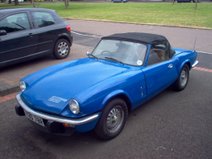It's always surprised me that you can't buy a baffled sump off the peg. It's also surprisingly difficult to find info about the best way to baffle a Spitfire sump. A lot of the 'tuning know how' books tell you that you need one but all of them seem to fall down when it comes to providing specific details...
Luckily the Internet provided a few answers with threads on the Club Triumph and Sideways Technologies forums providing some good nuggets of information from those that have done this before.
For me, the first thing to do was to get a spare sump from EBay. When this arrived I was surprised to see it came with a mesh screen over the deep part of the sump. After asking around I discovered that the early models were fitted with mesh like this to stop bits of metal being ingested by the oil pump. Later models have an oil strainer attached directly to the pump.
I decided to keep this mesh screen - a lot of aftermarket windage trays use a similar arrangement. This meant modifying it to fit my fatter (later) oil pump. I drilled a series of holes and used a small chisel knock out the metal I didn't need. This worked surprisingly well and the finished result, after filing, is very neat.

Next it was time to make a cardboard template. I decided to go for a flat plate to control front / rear movement, with a vertical piece running from front to back to control sideways movement. When I was happy with the templates I transferred the design to aluminium.
With the flat plate made up in alloy I realised I was going to have a problem getting it past the windage tray! I solved this by cutting it in two and drilling both halves for rivets. I then made the vertical baffle from a piece of L shaped alloy and drilled it so I could attach it to the horizontal plate - using it to neatly combine the two halves!

I then started thinking about how I should attach it to the sump. I didn't like the idea of bolts through the side of the sump so I decided to make some C shaped brackets and attach it to the windage tray. I decided to use rivets at the bottom and cap head bolts at the top. With the baffle now able to be attached, I riveted it up so I could test the baffle with a sump full of water.
It seemed to be pretty effective so I'm pretty happy with the design. All I need to do now is add the holes in the baffle for the oil pump and the dipstick and I'm done!




